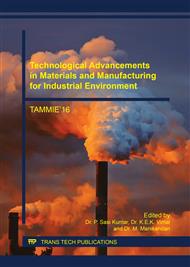p.29
p.34
p.41
p.48
p.58
p.64
p.73
p.81
p.88
An Experimental Investigation of the Properties of Self Curing Concrete Using Foundry Sand
Abstract:
The aim of this investigation is to study the use of the water soluble polyethylene glycol as self-curing agent. The function of self-curing agents is to reduce the water evaporation from concrete and hence they increase the water retention capacity of concrete compared to the conventionally cured concrete.The use of self-curing admixtures is very important from the point of view that saving of water is a necessity everyday (each one cubic meter of concrete requires 3m3 of water for a construction, most of which is used for curing). In this study, compressive strength and split tensile strength of concrete containing self-curing agent is investigated and compared with that of conventionally cured concrete.It is experimentally found by the authors that the concrete cast with polyethylene glycol as self-curing agent is stronger than that obtained by sprinkler curing as well as by immersion curing. In this project, foundry sand is replaced as a fine aggregate. It is also tested with conventional concrete and self curing concrete with 5% and 10% replacement of foundary sand which has been tested for compressive strength and split tensile strength for 7days and 28 days of curing and their results are compared. The compressive strength by 13.62%, 18.83% and 22.43%when compared to the Con mix at the age of 7 days and also 5.40%, 8.90% and 14.16% at the age of 28 days. Mixtures WSPG and WSPG with FS enhanced their tensile strength by 14.50%, 16.36% and 20.82% when compared to the Con mix at the age of 7 days and also 4.30%,8.15% and 12.90% at the age of 28 days.
Info:
Periodical:
Pages:
58-63
Citation:
Online since:
July 2017
Authors:
Price:
Сopyright:
© 2017 Trans Tech Publications Ltd. All Rights Reserved
Share:
Citation:


